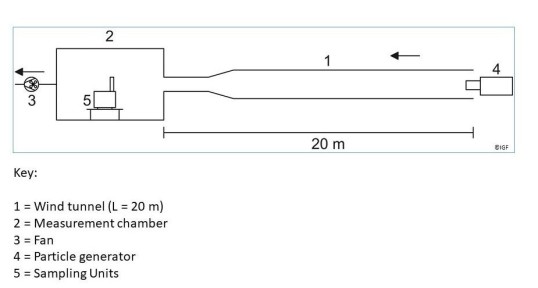- Artificial Intelligence (AI)
- Occupational exposure limit values
- Climate Change and Occupational Safety
- List of CMR substances
- Electromagnetic fields
- Ergonomics
- Industrial Security
- Collaborative robots
- Noise
- Nanoparticles at the workplace
- Optical Radiation
- REACH
- Reference materials
- Proficiency testing
- Vibration
- Virtual reality
- Work 4.0
Proficiency testing scheme for metals
Production of the sampling media
Filter samples bearing metal particles will be shipped. Sampling is performed by means of the total dust sampling system (GSP) on cellulose-nitrate filters (pore size: 8 µm; diameter: 37 mm) [1].
These samples are produced at the Institute for the Research of Hazardous Substances (IGF) of the German Social Accident Insurance Institution for the raw materials and chemical industry (BG RCI) in Dortmund. Aqueous metal salt solutions are pyrolysed by means of a flame generator. The resulting metal oxide particles are passed at a defined air flow rate through a steel tube (wind tunnel) with a length of 20 m and a diameter of 0.5 m (see figure). This tube opens into a measurement chamber with a volume of approximately 20 m³ in which the sampling units are located. Homogeneous distribution of the particles is assured at all points within the measurement chamber [2].
The concentrations are to be within a range of 0.1 to 2 times the applicable limit values (see table below). In consideration of the analytic performance of the analysis methods to be employed, deviating concentration ranges are expected to be selected for cobalt, nickel, chromium and indium. These will be made known in good time.
The analysis method (AAS methods, ICP) may be selected freely. The recommended digestion method is that published by the DFG (the German Research Foundation) [3] and the IFA folder No. 6015 [4] for the digestion of metal dusts.
In this IFA folder an open digestion and a microwave digestion can be used. In a comparative study it could be shown that both digestion methods can be used equivalently [5]. Short descriptions of the two digestion methods are sent to the participants together with the samples.
Limit values for metals in Germany
| Metal | Limit value in mg/m3 |
| Zn | 0.1 [6] |
| Cu | 0.01 [6] |
| Pb | 0.15 [6] |
| Ni | 0.006 [6] |
| Co | 0.0005 [6] |
| In | 0,0001 [6] |
| Mn | 0,02 [6] |
| Cr | 0,012* [6] |
| *following the limit value of chromium sulphate | |
Proficiency testing 2025

Contact

Department Chemical and Biological Hazards
Krista Gusbeth
Max Hasenbeck
Franziska Nürnberger
Ronja Schneck
Sources
[1] Ringversuch Metalle auf Filtern (Kennzahl 1630-4) In: IFA-Arbeitsmappe Messung von Gefahrstoffen. Lieferung 01/2022
[2] Monsé, C. et al.: Development and Evaluation of a Nanoparticle Generator for Human Inhalation Studies with Airborne Zinc Oxide. Aerosol Sci. Technol. 48 (2014) Nr. 4, S. 418-426
[3] Aufarbeitungsverfahren für Stäube zur Bestimmung des "Gesamtmetallgehaltes". In: DFG, Analytische Methoden zur Prüfung gesundheitsschädlicher Arbeitsstoffe, Luftanalysen. Band 1: Spezielle Vorbemerkungen, Abschnitt 4 "Probenahme und Bestimmung von Aerosolen und deren Inhaltsstoffen". 14. Lfg. Verlag Chemie, Weinheim 2005, S. 31-32
[4] Aufarbeitungsverfahren zur Analytik metallhaltiger Stäube, Methodik zur Bestimmung des "Gesamtmetallgehaltes" (Kennzahl 6015) In: IFA-Arbeitsmappe Messung von Gefahrstoffen. Lieferung 02/2018
[5] Pitzke, K.; Gusbeth, K.; Hebisch, R.; Kirchner, M.; Schuh, C.; Schwank, T.; Sonnenburg, R.; Timm, K.; Breuer, D., Projektstudie: Vergleich von Aufschlussverfahren für die Bestimmung des Gesamtmetallgehaltes in Staubproben (PDF, 406 kB, non-accessible) Teil 2: Ringversuch Teil 1, DFG-Arbeitsgruppe "Luftanalysen", Gefahrstoffe - Reinhaltung der Luft 78 (2018) Nr. 4, S. 138-151.

